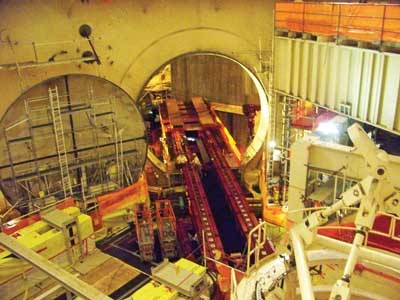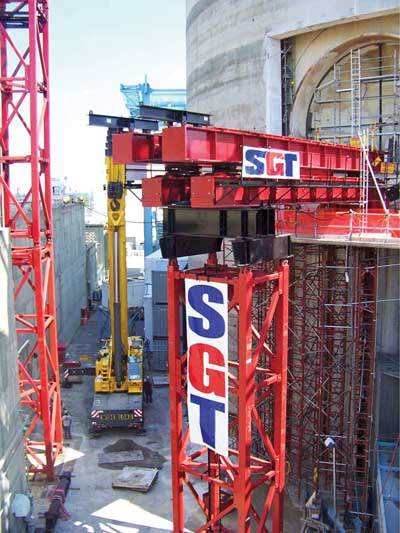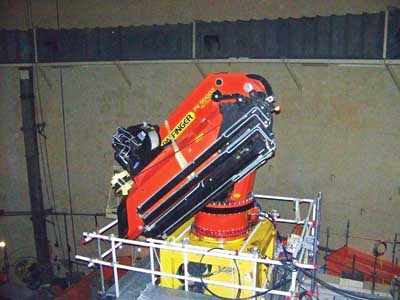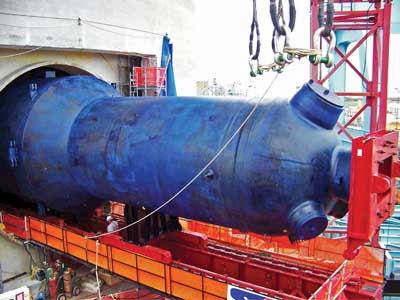St. Lucie Nuclear Generating Station, Unit 2, Hutchinson Island, Florida
Owner/Operator: Florida Power & Light
Florida Power & Light’s St. Lucie Unit 2 reactor vessel head and steam generator replacement project was an ambitious undertaking that required more than a year of intensive planning before the outage began. The highly motivated and experienced project team’s accomplishments are without equal. The team surely set a new industry standard for integrating a highly complex maintenance outage.
Florida Power & Light Co. (FPL) completed a scheduled refueling and maintenance outage at its St. Lucie Nuclear Power Plant Unit 2 during the fourth quarter of 2007 (Figure 1). But calling it merely a maintenance outage does a disservice to the project team. This was no routine refueling outage. It’s my opinion that this was one of the most ambitious and complex outages ever attempted in the nuclear power industry.

1. Florida coast fixture. Florida Power & Light’s St. Lucie Unit 2 recently completed a maintenance and refueling outage by replacing two steam generators, a reactor vessel head, and a reactor coolant pump while handling thousands of other work activities. Source: Nuclear Regulatory Commission
This project also demonstrates how fast a utility can spend millions in capital improvements to keep a nuclear plant in tip-top shape and ready for another 25 years of service.
St. Lucie Nuclear Power Plant is located on Hutchinson Island, about 8 miles southeast of Fort Pierce, along the east coast of southern Florida. It consists of two 829-MW pressurized water reactors, each featuring a freestanding carbon steel containment vessel with a reinforced concrete shield building forming an annular space between the vessel and shield building. Unit 1 entered commercial service in June 1976; Unit 2 followed in August 1983. Both units’ operating licenses were renewed by the Nuclear Regulatory Commission (NRC) in October 2003. The reactors were provided by Combustion Engineering.
A significant amount of work
The outage that earned Top Plant recognition began when Unit 2 was taken off-line Sept. 30, 2007, for the 17th refueling outage since it began commercial operation in 1983. More than 16,500 activities were accomplished during the outage. In addition to routine maintenance and the replacement of one-third of the unit’s 217 uranium fuel assemblies in the reactor core, the centerpiece of the outage work package was replacing the two steam generators and the reactor vessel head. Each steam generator is 63 feet tall, 19 feet in diameter, and weighs close to 500 tons. The reactor vessel head might be thought of as the reactor’s "lid," although it is about 8 feet high, 16 feet in diameter, and weighs more than 70 tons (Figure 2).

2. Off with its head. The old reactor vessel head was removed and then upended as it was extricated from the containment building Courtesy: SGT
The outage also included replacement of one of Unit 2’s four 6,500-horsepower reactor coolant pump motors; an alloy 600 mitigation project that deposited 120 pounds of weld metal on components in the containment area; and modifying the containment sump, a system inside the containment building that is used to collect and filter spilled coolant for reuse in the event of an accident.
Plan for success
The SGT LLC team, a URS Washington Division-AREVA NP joint venture, performed the steam generator (SG) and reactor vessel head replacements within what was an aggressive outage schedule established by FPL for the St. Lucie plant. The work inside the containment was complex but well-choreographed: Every step was carefully considered and integrated into a detailed written schedule prepared by FPL and SGT.
SGT provided project management, planning, engineering, and construction services for the installation of the two replacement steam generators. This included supplying all indirect labor management; direct hire craft labor; subcontractor management; permanent plant materials; miscellaneous equipment, tools, and supplies; and related costs and expenses to support the subcontractors. To support the outage plan, the team used the talents and expertise of employees throughout FPL’s nuclear fleet as well as the skills of more than 2,500 specialized contract workers.
SGT was also responsible for creating a temporary opening in the concrete shield wall and steel containment vessel; heavy rigging; offload and transport of the steam generators and reactor heads; and restoration of the containment building and affected systems to their original design configurations (Figure 3).

3. Crowd control. Inside the containment building, from left to right, are the steel containment vessel, hatch cover, hatch transfer system, main steam rupture restraint, and steam generator “A”. Courtesy: SGT
FPL realized the need to keep a successful project team intact after completing its recent Turkey Point Reactor Head Replacement Project, so a core team of SGT and FPL staff remained together for more than four years, working first at Turkey Point, and then at St. Lucie. Both SGT and FPL embraced the integrated project team approach, which blurred the distinction between companies. This teamwork was especially crucial during the implementation phases of the project, when problem-solving occurred seamlessly due to the existing collaborative relationship.
Innovate for success
One characteristic of the project team was its spirit of innovation. Team members were willing to adopt new technologies that would reduce labor man-hours expended during the outage. For example, the team adopted the first-of-a-kind use of Netherlands-based Mammoet’s containerized winch system (CWS) crane. The CWS, jointly developed by SGT and Mammoet, was used to lift large components (up to 650 tons) and improve travel speeds of the major component rigging evolutions (Figure 4). Any reduction in travel time results in a critical-path savings to the outage schedule, which was vital to meeting the objectives of schedule adherence and cost certainty.

4. Open wide. This hatch transfer system was employed for removing the steam generators using a containerized winch system jointly developed by SGT and Mammoet. Courtesy: SGT
The project team also successfully implemented computerized radiographic testing on all welds requiring radiography to reduce schedule, dose, and work area boundary issues. This was a key element in achieving the project goal of minimizing general work area disruption and helped increase worker efficiency.
Safety first
Steam generator replacement projects pose a significant challenge to employee safety, because work is performed in an operating facility with a large variety of potential physical and radiological hazards. These challenges include high-radiation areas, confined spaces, heavy rigging, and hot work in close quarters (Figure 5). To ensure the project’s success, each task was meticulously planned. SGT’s safety-conscious approach has helped set the industry standard for top performance under aggressive project schedules.

5. Moving on. A Palfinger crane was also used for heavy lifts of piping and components. Courtesy: SGT
SGT and FPL achieved superior results in all areas of safety, as low as reasonably achievable (ALARA) radiation exposure, and quality. The team’s safety record is attributable to a program that drove the responsibility for safety through all levels of the organization and project. It held all workers accountable for their own safety and the safety of their coworkers. Employee orientation and training addressed personal attitudes toward safety and ensured that all employees attained a sense of ownership of the safety program and culture. The project team members were always aligned in terms of safety performance and behavior expectations.
Team safety achievements include the following:
-
During more than 1 million project man-hours there were only two Occupational Safety and Health Administration (OSHA) recordable incidents and zero lost-time incidents.
-
The team beat its radiation safety project goal by 4.5%, accumulating 107 person-rem versus a goal of under 112 person-rem.
-
Eighty-eight percent of project staff were Safety Trained Supervisor certified.
-
Ninety-four percent of eligible construction supervision staff received OSHA 10-hour certification.
-
Over 30% of project staff had CPR and defibrillator training.
-
Perfect fire hazard performance was achieved when conducting welding, preheat, and postweld heat treatment.
-
A comprehensive temporary shielding program was implemented to minimize employees’ radiological dose exposure.
-
Weekly pre-outage, daily outage safety, and daily toolbox safety meetings were held.
Managing and mitigating risks
The construction team identified risk areas and took problem mitigation and elimination measures wherever possible. For example, the team developed innovative solutions to potential steam generator haul route interferences. Doing so was significant, as the time and labor required to dismantle and restore a cask crane for a single potential interference would have cost as much as $360,000.
The viability of using two smaller transporters to move the steam generators was first verified by computer modeling and then with a physical mock-up. The construction team coordinated with Mammoet and the plant’s engineering department to create a three-dimensional mock-up of the steam generator in conjunction with the offload of the steam generator. By scheduling in conjunction with the off-load of the replacement steam generators, the mock-up was performed with equipment that was already on site, mitigating mobilization costs. The end result was proof that the cask crane would not need to be dismantled (Figure 6).

6. Skid row. The old “B” steam generator was skidded out of the containment building. Courtesy: SGT
The SGT project team utilized a task management approach that empowered each task manager to be a "mini" project manager for an element of the overall project. A comprehensive risk identification and mitigation program was the core of the task plan, and the task manager could identify risks that were then rolled up into an overall project risk assessment to provide for contingency plans and drawdown schedule.
The project team spent considerable time studying lessons learned from previous steam generator replacements, especially those concerning rigging equipment and contractor oversight. As a result, task managers were assigned to provide contractor oversight and to integrate key contractors into the teaming plan; rigging equipment was test-fit prior to the outage to minimize risk.
Making quality welds
Good welds begin with quality pipefitting. The team optimized the installation geometry and achieved superior fit-up (less than 0.01-inch gap on all primary nozzles) by using its GenFit technology. This technology incorporates close-range photogrammetry with proprietary analytic processing to achieve consistent world-class fit-up results.
The success achieved on reactor coolant system (RCS) welds (all welds were performed with zero rejectable indications) included the use of a narrow-groove weld joint design and simultaneous ID/OD welding of the RCS hot legs to reduce outage duration. This was the first time SGT had used simultaneous welding of the joint, which saved time on the project’s critical path schedule. SGT achieved first-time weld quality on all large-bore primary and secondary welds through a rigorous welder training and proficiency testing program that the team established. The investment in this program provided for first-time weld quality of the following radiographically tested weld joints:
-
Six RCS welds (2 x 42 inches in diameter with a wall thickness of 5 inches and 4 x 36 inches in diameter with a wall thickness of 4.375 inches).
-
Four main steam line welds (34 inches in diameter and 2-inch wall thickness).
-
Two feedwater system welds (18 inches in diameter and 2.675-inch wall thickness).
-
The steel containment vessel weld was approximately 31 feet in diameter with a wall thickness of 1.125 inches.
-
Simultaneous ID/OD welding of the reactor hot leg welds was extremely successful. This enabled the construction department to reduce the overall critical path duration by 59 hours — a huge success for the project.
Incremental improvement
SGT had previously performed a reactor vessel head replacement in conjunction with the first pressurizer replacement in the industry at St. Lucie Unit 1. That project established a world record for low radworker dose for a reactor vessel head and pressurizer replacement.
Similarly, the lessons learned from the St. Lucie Unit 2 project will be incorporated into future projects to further improve the execution of large nuclear component replacement projects. Today’s record becomes tomorrow’s expectation.